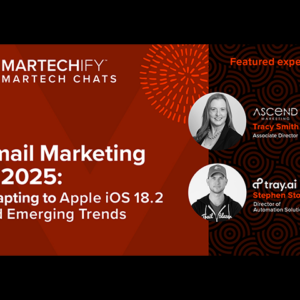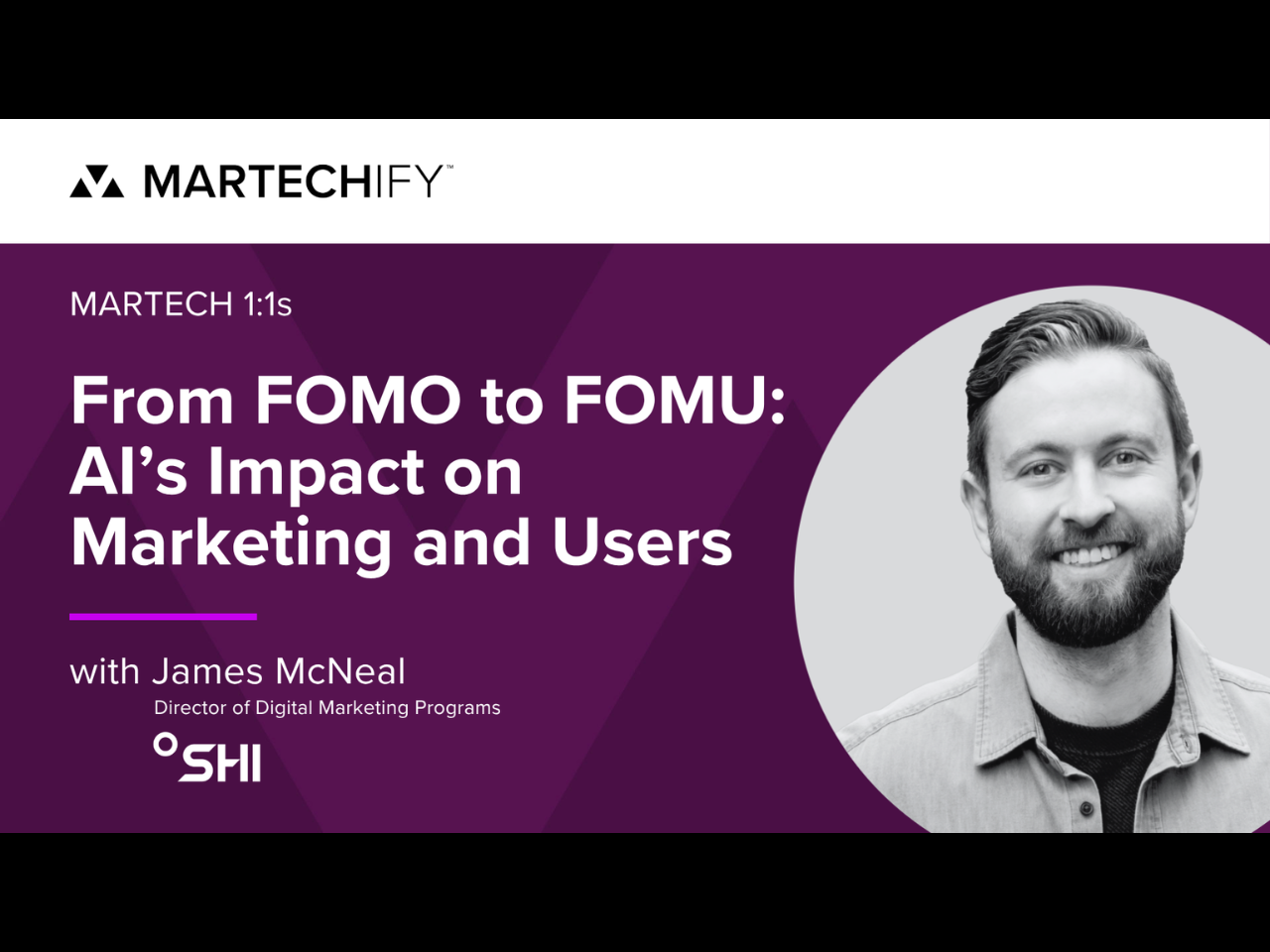The Marketing IT Department of One: Revolutionizing Marketing Operations at Payroc
- Caitlin Johnson, Manager, Marketing Technology & Operations at Payroc
- AI and Automation, Campaign Optimization, Customer Experience (CX), Digital Transformation, Lead Gen / Lead Mgmt, Managing Org Transformation, Martech Stacks
While most professionals were setting up home offices during the pandemic, Caitlin Johnson was automating her grocery shopping—creating a workflow that selected weekly recipes and sent ingredient lists directly to delivery apps. Caitlin channels this same obsession with automation to revolutionize marketing operations at Payroc.
We interviewed Caitlin Johnson and we’re honored to bring you her thoughts on creating a dedicated martech role at Payroc. As Manager of Marketing Technology and Operations, Caitlin has pioneered a position that many companies are only beginning to recognize they need—a dedicated expert who bridges the gap between marketing teams and technology.
“I joke that I’m just our marketing team’s IT person, they get their own personal IT person and that’s me,” says Caitlin, describing her unique role at Payroc, a financial technology company with over 1,200 employees across the US, Canada, and the UK.
When Caitlin joined Payroc nearly two years ago, they didn’t have anyone focused specifically on marketing technology. While this might sound like a minor detail, the reality is that modern marketing departments often manage dozens of specialized tools—each requiring configuration, integration, and optimization. Without someone leading this effort, marketing teams inevitably waste time, miss opportunities, and struggle with disjointed systems.
We interviewed Caitlin Johnson and we’re honored to bring you her thoughts on creating a dedicated martech role at Payroc. As Manager of Marketing Technology and Operations, Caitlin has pioneered a position that many companies are only beginning to recognize they need—a dedicated expert who bridges the gap between marketing teams and technology.
“I joke that I’m just our marketing team’s IT person, they get their own personal IT person and that’s me,” says Caitlin, describing her unique role at Payroc, a financial technology company with over 1,200 employees across the US, Canada, and the UK.
When Caitlin joined Payroc nearly two years ago, they didn’t have anyone focused specifically on marketing technology. While this might sound like a minor detail, the reality is that modern marketing departments often manage dozens of specialized tools—each requiring configuration, integration, and optimization. Without someone leading this effort, marketing teams inevitably waste time, miss opportunities, and struggle with disjointed systems.
The evolution of a martech professional
Caitlin’s path to becoming a martech specialist began during her freelance years, where she quickly recognized that many creative business owners needed fundamental technology support before they could even think about marketing campaigns.
“A lot of them wanted to bring somebody on to do these big marketing campaigns to grow their lead generation, which of course, everybody wants,” Caitlin explains. “But when actually getting into the nitty-gritty with a lot of them, [I realized] they don’t have a CRM, they don’t have any automations or workflows for lead nurturing.”
This early experience set the pattern for her professional approach—before focusing on high-level marketing, you must ensure the foundational systems are in place.
She worked extensively with:
— Photographers
— Wedding industry professionals
– Creative business owners
In each case, she helped them move beyond ad hoc approaches like managing clients through Facebook messages and toward structured systems that could scale with growth.
After settling in Las Vegas, Caitlin transitioned from freelance work to roles with:
— Nobel Learning Communities (managing regional marketing and Salesforce CRM)
— SAFY (a nonprofit where she managed marketing, CRM, and project management)
— Payroc, after joining a tech industry networking group called Pathrise where she was introduced to the fintech community, which eventually led her to Payroc
— Though her degree was in business administration and management, Caitlin gravitated naturally toward technical solutions based on a simple philosophy: “I am truly the laziest employee,” Caitlin joked. “Because I want to find the quickest and most efficient way to do everything.”
This efficiency mindset extends even to her personal life—she set up personal workflows in Monday.com that would automatically send her weekly recipe ingredients to a grocery delivery app.
“A lot of them wanted to bring somebody on to do these big marketing campaigns to grow their lead generation, which of course, everybody wants,” Caitlin explains. “But when actually getting into the nitty-gritty with a lot of them, [I realized] they don’t have a CRM, they don’t have any automations or workflows for lead nurturing.”
This early experience set the pattern for her professional approach—before focusing on high-level marketing, you must ensure the foundational systems are in place.
She worked extensively with:
— Photographers
— Wedding industry professionals
– Creative business owners
In each case, she helped them move beyond ad hoc approaches like managing clients through Facebook messages and toward structured systems that could scale with growth.
After settling in Las Vegas, Caitlin transitioned from freelance work to roles with:
— Nobel Learning Communities (managing regional marketing and Salesforce CRM)
— SAFY (a nonprofit where she managed marketing, CRM, and project management)
— Payroc, after joining a tech industry networking group called Pathrise where she was introduced to the fintech community, which eventually led her to Payroc
— Though her degree was in business administration and management, Caitlin gravitated naturally toward technical solutions based on a simple philosophy: “I am truly the laziest employee,” Caitlin joked. “Because I want to find the quickest and most efficient way to do everything.”
This efficiency mindset extends even to her personal life—she set up personal workflows in Monday.com that would automatically send her weekly recipe ingredients to a grocery delivery app.
Creating a role where none existed
When Caitlin arrived at Payroc, there was an immediate red flag: “Our integration with Salesforce and HubSpot is breaking all the time. Leads are constantly not syncing.”
Her first major project required auditing over 500 forms collecting data and ensuring they had the correct criteria to send leads where they needed to go. This was especially complex because Payroc has multiple sales channels, each requiring different routing rules:
— Integrated sales
— Direct sales
— Agent ISO (Independent Sales Organizations) recruiting
After tackling the Salesforce/HubSpot integration, Caitlin then moved to her next major project: transitioning the marketing team from Jira to Monday.com for project management.
“Jira is a great tool. It’s great for sprint management, it’s great for IT,” Caitlin notes, “but it’s not super great for creative.”
The migration brought immediate benefits:
— Anyone could fill out project request forms without needing Monday.com credentials
— Automated email updates kept requesters informed of progress
— Better handling of sub-items and nested tasks
— Smoother automation capabilities
The impact was significant for a marketing team receiving over 200 requests per month for content, sales materials, and design work.
Her first major project required auditing over 500 forms collecting data and ensuring they had the correct criteria to send leads where they needed to go. This was especially complex because Payroc has multiple sales channels, each requiring different routing rules:
— Integrated sales
— Direct sales
— Agent ISO (Independent Sales Organizations) recruiting
After tackling the Salesforce/HubSpot integration, Caitlin then moved to her next major project: transitioning the marketing team from Jira to Monday.com for project management.
“Jira is a great tool. It’s great for sprint management, it’s great for IT,” Caitlin notes, “but it’s not super great for creative.”
The migration brought immediate benefits:
— Anyone could fill out project request forms without needing Monday.com credentials
— Automated email updates kept requesters informed of progress
— Better handling of sub-items and nested tasks
— Smoother automation capabilities
The impact was significant for a marketing team receiving over 200 requests per month for content, sales materials, and design work.
The philosophy of marketing technology excellence
What makes Caitlin’s approach distinctive is her proactive stance toward tool evaluation and selection. She doesn’t wait for problems to develop or for team members to request solutions—she’s constantly exploring what’s available.
“When I get those LinkedIn messages of, ‘Hey, do you want to book a demo for this?’ Yes, I do. Tell me what’s out there, what’s going on? I am on all the demo calls,” she explains.
This forward-looking approach serves several purposes:
— It keeps her aware of new tools and capabilities
— It allows her to anticipate needs before they become urgent
— It removes the burden of tool research from creative team members
— It ensures new tools will integrate with existing systems
Caitlin sees her role as providing infrastructure that allows creative marketers to focus on their core skills. With hundreds of marketing tools available in the market, having someone dedicated to understanding and managing that ecosystem creates tremendous value.
The martech stack she manages at Payroc includes:
— Salesforce and HubSpot for CRM and marketing automation
— Monday.com for project management
— Apollo for lead generation
— GatherUp for reviews and reputation management
— MailChimp for internal emails
— BrandFolder for marketing asset management
— GaggleAMP for social media amplification
Each tool serves a specific purpose, and Caitlin ensures they work together as a cohesive system rather than isolated solutions.
“When I get those LinkedIn messages of, ‘Hey, do you want to book a demo for this?’ Yes, I do. Tell me what’s out there, what’s going on? I am on all the demo calls,” she explains.
This forward-looking approach serves several purposes:
— It keeps her aware of new tools and capabilities
— It allows her to anticipate needs before they become urgent
— It removes the burden of tool research from creative team members
— It ensures new tools will integrate with existing systems
Caitlin sees her role as providing infrastructure that allows creative marketers to focus on their core skills. With hundreds of marketing tools available in the market, having someone dedicated to understanding and managing that ecosystem creates tremendous value.
The martech stack she manages at Payroc includes:
— Salesforce and HubSpot for CRM and marketing automation
— Monday.com for project management
— Apollo for lead generation
— GatherUp for reviews and reputation management
— MailChimp for internal emails
— BrandFolder for marketing asset management
— GaggleAMP for social media amplification
Each tool serves a specific purpose, and Caitlin ensures they work together as a cohesive system rather than isolated solutions.
Real-world impact and solutions
One illustrative example of Caitlin’s approach involved a colleague struggling with newsletter management:
“One of my colleagues a couple weeks ago sent me something saying, ‘Hey, we have these 25 lists we’re sending a newsletter to every month, and I have to manually update to see who’s still active.’ And I said, ‘Let’s please never do this again! We’re gonna fix that immediately.'”
The solution was an elegantly simple workflow in HubSpot that:
1. Consolidated 25 separate lists into one master list
2. Automatically removed subscribers who hadn’t engaged in 120 days
3. Automatically updated when people were added to any of the source lists
4. Removed unsubscribed contacts for accurate reporting
This exemplifies Caitlin’s approach—she doesn’t just implement tools, she creates processes that save time and eliminate tedious manual work.
“One of my colleagues a couple weeks ago sent me something saying, ‘Hey, we have these 25 lists we’re sending a newsletter to every month, and I have to manually update to see who’s still active.’ And I said, ‘Let’s please never do this again! We’re gonna fix that immediately.'”
The solution was an elegantly simple workflow in HubSpot that:
1. Consolidated 25 separate lists into one master list
2. Automatically removed subscribers who hadn’t engaged in 120 days
3. Automatically updated when people were added to any of the source lists
4. Removed unsubscribed contacts for accurate reporting
This exemplifies Caitlin’s approach—she doesn’t just implement tools, she creates processes that save time and eliminate tedious manual work.
Supporting diverse marketing strategies
What makes Caitlin’s role particularly interesting at Payroc is how she supports multiple marketing approaches across different sales channels. Rather than enforcing a one-size-fits-all solution, she adapts to the specific needs of each team:
“Each sales channel has their own marketing lead,” Caitlin explains. “Lorena’s our lead for the agent ISO in direct sales. So she’ll say, ‘Hey, for our agent ISO team, I want us to do a lot of content, very content heavy and very event heavy.'”
This requires Caitlin to be adaptable and responsive to varying approaches:
— The agent ISO team focuses on content marketing and industry events
— Inside sales also prioritizes event marketing
— Integrated sales uses content but also leverages Apollo for cold emailing
— Each team targets different vertical markets with specialized needs
When a sales or marketing leader identifies a need, Caitlin becomes both guide and implementer. For instance, when the head of integrated sales wanted a solution for cold email lead generation, Caitlin researched options, made recommendations, and then handled the technical integration once a decision was made.
“I want them to know, ‘Hey, I can go to Caitlin, and she’s probably already heard of something, or she already has something that we have that we can already use for this,'” she says.
This consultative approach means marketing team members don’t need to become technology experts themselves—they can focus on strategy and content while Caitlin ensures the technical foundation supports their goals.
“Each sales channel has their own marketing lead,” Caitlin explains. “Lorena’s our lead for the agent ISO in direct sales. So she’ll say, ‘Hey, for our agent ISO team, I want us to do a lot of content, very content heavy and very event heavy.'”
This requires Caitlin to be adaptable and responsive to varying approaches:
— The agent ISO team focuses on content marketing and industry events
— Inside sales also prioritizes event marketing
— Integrated sales uses content but also leverages Apollo for cold emailing
— Each team targets different vertical markets with specialized needs
When a sales or marketing leader identifies a need, Caitlin becomes both guide and implementer. For instance, when the head of integrated sales wanted a solution for cold email lead generation, Caitlin researched options, made recommendations, and then handled the technical integration once a decision was made.
“I want them to know, ‘Hey, I can go to Caitlin, and she’s probably already heard of something, or she already has something that we have that we can already use for this,'” she says.
This consultative approach means marketing team members don’t need to become technology experts themselves—they can focus on strategy and content while Caitlin ensures the technical foundation supports their goals.
Industry personalization through automation
One of the most sophisticated automations Caitlin has implemented involves personalizing content based on industry classification.
“One of the biggest things that we’re working on right now is when we have a lead that becomes an opportunity, at that point, we know their industry and can update core content to include industry-specific keywords,” she explains.
This information triggers a cascade of personalization:
1. A sales rep identifies the prospect’s industry in Salesforce
2. This classification syncs to HubSpot
3. HubSpot workflows automatically update content fields with industry-specific terminology
4. Marketing emails now include personalized language for that vertical
For example, if a prospect is in the car wash industry, all future communications will include car wash terminology. Golf club management clients receive golf-specific language in their emails.
“Doing all that on an automated basis so that the core content stays the same, but it still feels like they got it knowing them,” says Caitlin. “I think it is a really fun automation that we’re working on.”
This level of personalization would be extremely labor-intensive without automation, but with the right technical foundation, it happens seamlessly.
“One of the biggest things that we’re working on right now is when we have a lead that becomes an opportunity, at that point, we know their industry and can update core content to include industry-specific keywords,” she explains.
This information triggers a cascade of personalization:
1. A sales rep identifies the prospect’s industry in Salesforce
2. This classification syncs to HubSpot
3. HubSpot workflows automatically update content fields with industry-specific terminology
4. Marketing emails now include personalized language for that vertical
For example, if a prospect is in the car wash industry, all future communications will include car wash terminology. Golf club management clients receive golf-specific language in their emails.
“Doing all that on an automated basis so that the core content stays the same, but it still feels like they got it knowing them,” says Caitlin. “I think it is a really fun automation that we’re working on.”
This level of personalization would be extremely labor-intensive without automation, but with the right technical foundation, it happens seamlessly.
The future of marketing operations
Looking ahead, Caitlin is carefully exploring how AI might enhance marketing operations. She’s a member of the Responsible AI Institute and stays current on developments but takes a measured approach to implementation.
“As far as utilizing AI for personalized content, we have not fully gone into that,” she notes. “We have too many contacts in our system to feel confident with AI’s ability to manage that.”
For now, AI use at Payroc is primarily used as support and is focused on:
— Content creation and editing by the content team
— Creative applications in graphics design
— Dashboard summarization in tools like HubSpot
Caitlin’s approach to marketing technology is rooted in continuous learning and adaptation. As she puts it, “I think it’s important in this role specifically, I feel like, to not get caught in the ‘well, we’ve always done it this way’ because that is the death of innovation.”
“As far as utilizing AI for personalized content, we have not fully gone into that,” she notes. “We have too many contacts in our system to feel confident with AI’s ability to manage that.”
For now, AI use at Payroc is primarily used as support and is focused on:
— Content creation and editing by the content team
— Creative applications in graphics design
— Dashboard summarization in tools like HubSpot
Caitlin’s approach to marketing technology is rooted in continuous learning and adaptation. As she puts it, “I think it’s important in this role specifically, I feel like, to not get caught in the ‘well, we’ve always done it this way’ because that is the death of innovation.”
Key takeaways for marketing leaders
Caitlin’s experience offers valuable lessons for companies considering how to structure their marketing technology function:
— A dedicated martech specialist can eliminate countless technology-related bottlenecks
— The liaison between marketing, sales, and IT should be someone who genuinely enjoys exploring and evaluating new tools
— The best marketing operations professionals are ruthlessly focused on efficiency
— Successful marketing technology implementation requires understanding both business goals and technical capabilities
— Systems integration expertise is increasingly critical as the number of specialized tools continues to grow
As marketing departments continue to increase their technology spend and dependence on specialized tools, the need for roles like Caitlin’s will only grow. By serving as the marketing department’s personal IT specialist, she enables creative professionals to focus on their core strengths while maintaining a technical foundation that drives efficiency and results.
For companies struggling with marketing technology integration, performance, or adoption, the answer might not be more tools or more training—it might be finding your own Caitlin Johnson.
— A dedicated martech specialist can eliminate countless technology-related bottlenecks
— The liaison between marketing, sales, and IT should be someone who genuinely enjoys exploring and evaluating new tools
— The best marketing operations professionals are ruthlessly focused on efficiency
— Successful marketing technology implementation requires understanding both business goals and technical capabilities
— Systems integration expertise is increasingly critical as the number of specialized tools continues to grow
As marketing departments continue to increase their technology spend and dependence on specialized tools, the need for roles like Caitlin’s will only grow. By serving as the marketing department’s personal IT specialist, she enables creative professionals to focus on their core strengths while maintaining a technical foundation that drives efficiency and results.
For companies struggling with marketing technology integration, performance, or adoption, the answer might not be more tools or more training—it might be finding your own Caitlin Johnson.













